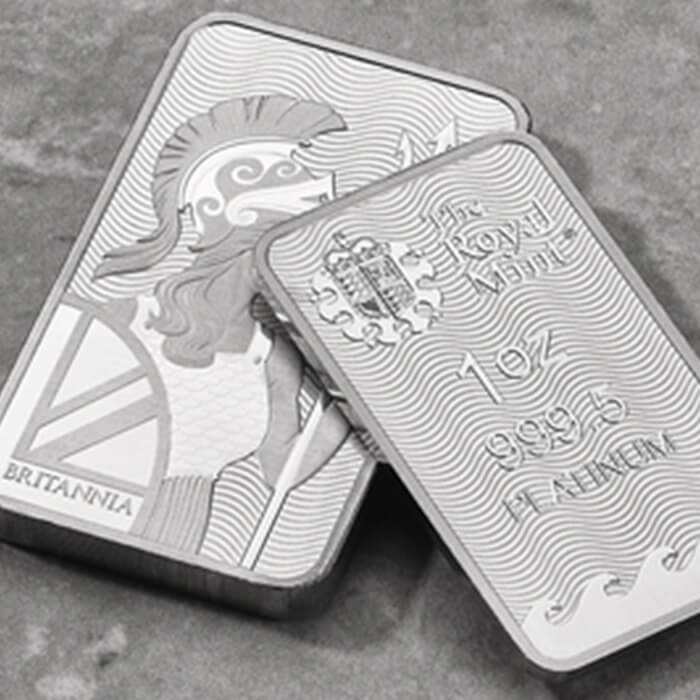![Web Desktop Hero Banner [1600×800] 2.png](/globalassets/bullion/_new_structure/discover-bullion/guides/market-updates-2023/march/web-desktop-hero-banner-1600800-2.png)
Precious Metal Prices
March opened with a gold price of $1,833.50, before climbing to $1,849.05 as trading closed on 6 March. Although prices have been steadily increasing in recent days, this represents a significant decrease from the high of $1,954.90 seen in early February.
Notably, February represented the lowest gold price since June 2021, following United States data pointing towards a strong economy and low unemployment. Although an increase in demand for gold was recorded in China – partly due to the rapid expansion of manufacturing activity during February – higher interest rates seen in many regions have generally led to a decrease in demand for gold as an inflation hedge. The ongoing concerns around the prospect of rising US interest rates further limited gains. The dollar index fell 0.5% after increasing almost three percent in February, making gold cheaper and more appealing for foreign buyers.
Similar fluctuations have been seen across other precious metals, including silver, which was priced at $21.08 per ounce on 6 March following a high of $24.43 at the start of February.
Indian Demand for Silver
In 2022, India saw a surge in silver imports, with 8,800 tonnes coming into the region. This is a departure from India's traditional preference for gold and, according to the LBMA, can be attributed to the favourable investment sentiment and rebuilding of stock by fabricators and retailers. This reflects the continued faith of Indian consumers in precious metals as a store of value, with demand expanding across jewellery, investment and industrial segments.
Previously, 2020 saw a drop in total silver demand to 3,150 tonnes due to the pandemic-induced slowdown. Although 2021 saw a slight improvement, volumes struggled to return to pre-pandemic levels due to depleted household income and higher silver prices in local currency terms.
![Article Secondary Image [1000 x 500] 1.png](/globalassets/bullion/_new_structure/discover-bullion/guides/market-updates-2023/march/article-secondary-image-1000-x-500-1.png)
Central Bank Purchases
Türkiye became the world’s largest buyer of gold amongst central banks in January, purchasing 23 tonnes of the precious metal. This purchase took Türkiye's total gold holdings to 565 tonnes, which is the highest level on record, according to data from the World Gold Council. The People's Bank of China and the National Bank of Kazakhstan were the second and third biggest buyers of gold during this period, acquiring 15 tonnes and four tonnes respectively.
Although Türkiye has been recorded as a large purchaser of gold for some time, last month the country suspended some gold imports temporarily to mitigate the economic fallout from the devastating earthquakes seen across the region.
Interest Rates and the US
Gold prices have taken a hit in recent days as investors and traders anxiously await signals on future rate hikes from US Federal Reserve Chair Jerome Powell's testimony this week. In Powell's previous appearance a month ago, he emphasised the ‘disinflation’ theme and avoided adopting an aggressive tone, but traders are closely watching for a potential shift in stance, given the recent strong economic data.
Traders are expecting that the Federal Reserve raise its target rate to 5.425% in September from the current 4.5%-4.75% range. If Powell's remarks indicate a more hawkish tone, this could lead to further rate hikes sooner than expected, potentially causing gold prices to drop even further. On Tuesday, Powell's comments about the potential need for higher interest rates rattled the market, causing the dollar index to surge and making gold more expensive for overseas buyers.
The upcoming US jobs report for February could provide more insight into the future of interest rates. If the report shows significant strength in the US labour market, this could lead to even higher US interest rates, potentially unwinding the month-to-date gains garnered by gold. Powell's remarks during his testimony will be closely watched as financial markets look to reaffirm the recent repricing higher of Fed rate expectations. A similar undertone to his previous appearance could boost gold prices, while a more hawkish tone could cause them to drop further.
Russia and Iran
The Central Bank of Russia and the Central Bank of Iran have been reportedly working together to develop a gold stablecoin, which could be used for efficient trade between the two countries. It is suggested that both countries could increase their trade volume to over $10bn per year by using digital financial assets secured by gold. The token would be a stablecoin, backed by gold, which would replace the US dollar, Russian ruble, and Iranian rial in foreign trade payments. The recording of transactions would be handled by a decentralized ledger using blockchain technology. It is said that, if successful, this new system could render sanctions ineffective and alter the world's economic structure.
![Article Tertiary Image [1000 x 500] 2.png](/globalassets/bullion/_new_structure/discover-bullion/guides/market-updates-2023/march/article-tertiary-image-1000-x-500-2.png)
The Royal Mint Achieves Shari'ah Standard on Gold Compliance
The Royal Mint has achieved compliance with the Shari'ah Standard on Gold for retail sales of our gold and silver bullion coins and bars, enabling us to serve an even wider audience of investors via our website royalmint.com/invest.
The Royal Mint’s bullion has been endorsed as Sharia-compliant by Sharia advisory organisation Amanie Advisors, in accordance with the Shari'ah Standard on Gold. This standard is set by the Accounting and Auditing Organisation for Islamic Financial Institutions (AAOIFI) and has been developed in co-operation with the London-based World Gold Council (WGC).




